Design
Design
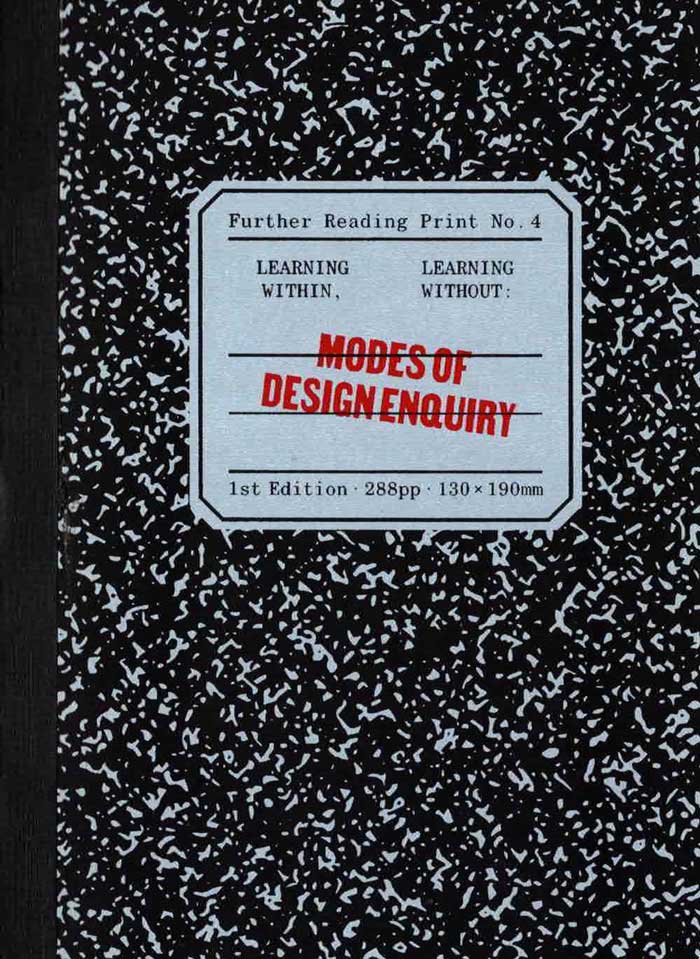
No.4: Learning Within, Learning Without
Januar Rianto, Almer Mikhail and 1 more
There is no one-size-fits-all approach to design. It is as much a practice as it is a methodology or way of thinking, a multifaceted discipline that moves with society’s progression. Throughout the creative process behind every design, learnings happen. Designers learn to adapt, adjusting their positions relative to the context. This volume spotlights self-organised, spontaneous, sporadic, and informal educational initiatives within the realm of creative practices, both historical and contemporary. The initiatives presented here show that any attempt to control a narrative and limit it to a single understanding risks stifling potential innovations that might arise from unexpected origins.
Featuring contributions from Amanda Ariawan, Andriew Budiman, Carlos Romo-Melgar, Chabib Duto Hapsoro, Czar Kristoff J.P., Filippo Sciascia, Fiorent Fernisia, Gideon Kong, Jacob Lindgren, Jeremy Sharma, Keni K. Soeriaatmadja, Limestone Books, Livian Aurel V. Purwanto, Mac Andre Arboleda, Nishkra, Prananda L. Malasan, R.A. Dita Saraswati, Reza Afisina, Rouzel Waworuntu Saad, Savira Aristi, Trevor Embury, and Virliany Rizqia Putri.
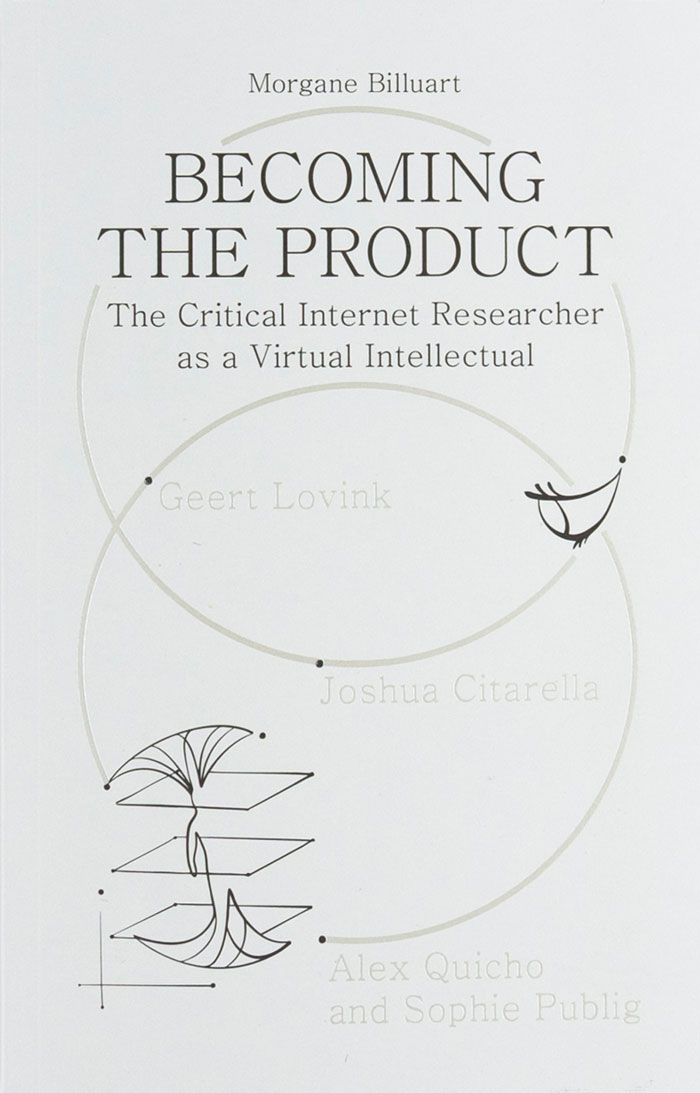
Becoming the Product
In Becoming the Product: The Critical Internet Researcher as a Virtual Intellectual, the evolution of critical internet research takes center stage. By examining the pioneering work of early net critic Geert Lovink and the influencer-style approach of internet theorist Joshua Citarella, as well as the practices of Alex Quicho and Sophie Public, this essay delves into the diverse strategies internet researchers adopt to share their work and sustain their careers more or less independently in today's era defined by the attention economy.
Charting the rise of subscription-based platforms and the increasing importance of engagement-driven metrics, Becoming the Product uncovers the tension between intellectual critique and the pressures of commodification. As the lines blur between rigorous scholarship, aesthetic branding, and market-driven content, Becoming the Product investigates the future of critical internet research and the sustainability of critical thinking as we know it in the digital age.

Strangers need strange moments together
Melissa Mongiat, Mouna Andraos
This book frequently uses the word ‘we’. We, as in the general public, engaged citizens, humans of planet Earth… And we, Mouna Andraos and Melissa Mongiat, together with our team at Daily tous les jours, as we seek new models for living together. Welcome to our journal.
We crave living in environments that support us, nourish us and inspire us. We dream of places to go through our lives together, inclusively and tolerantly. Can we re-enchant the raw material of our collective daily experiences? We have been creating interactive art and narrative experiences in public spaces around the world for fifteen years. Using music, dance, art, and other mediums to emphasize the joyful, whimsical, and unexpected, we create moments of connection and care between strangers.
Through this book, we share our experience in building an emergent practice combining technology, storytelling, performance, and design, while asking fundamental questions to create meaningful work in a world in crisis. Meet us outside the urban masterplan, where we experiment with infrastructure for the human spirit.
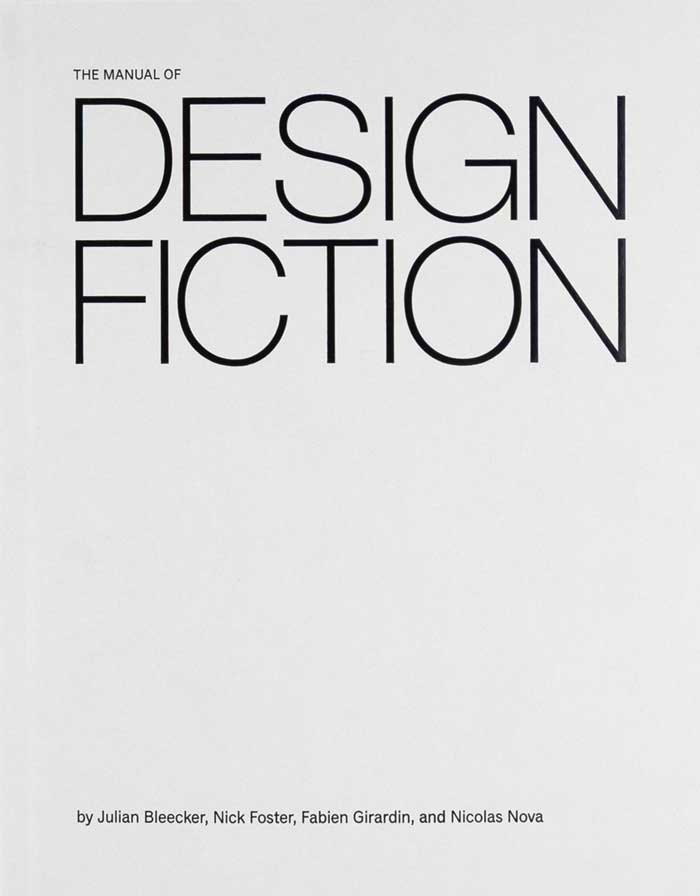
The Manual of Design Fiction
Julian Bleecker, Nick Foster and 2 more
Design Fiction is a method to vividly render tangible futures by creating material artifacts that represent the implications of change. Design Fiction is as much a mindset as it is a methodology whereby foresight, research, expectations, strategic direction, and planning can be cohered into representational ‘artifacts from possible futures.’from possible futures. Design fiction opens up new conversations and considerations whilst augmenting existing, well-trodden research and foresight practices.
Over fifteen years in the making, this book explores the origins of design fiction, and details the practical approach to assessing the consequences of decision making by creating tangible artifacts from possible futures. Design fiction opens up new conversations and considerations whilst augmenting existing, well-trodden research and foresight practices. The writers of this book have used design fiction approaches with clients such as Apple, Warner Bros, IKEA, Edelman, Dubai Museum of the Future, Google and Facebook, and they aim to bring these techniques to a wider audience through the publication of this book.
Written by Julian Bleecker, Nick Foster, Fabien Girardin and Nicolas Nova in collaboration with Patrick Pittman and Chris Frey of No Media Co. Designed by Chris Lange
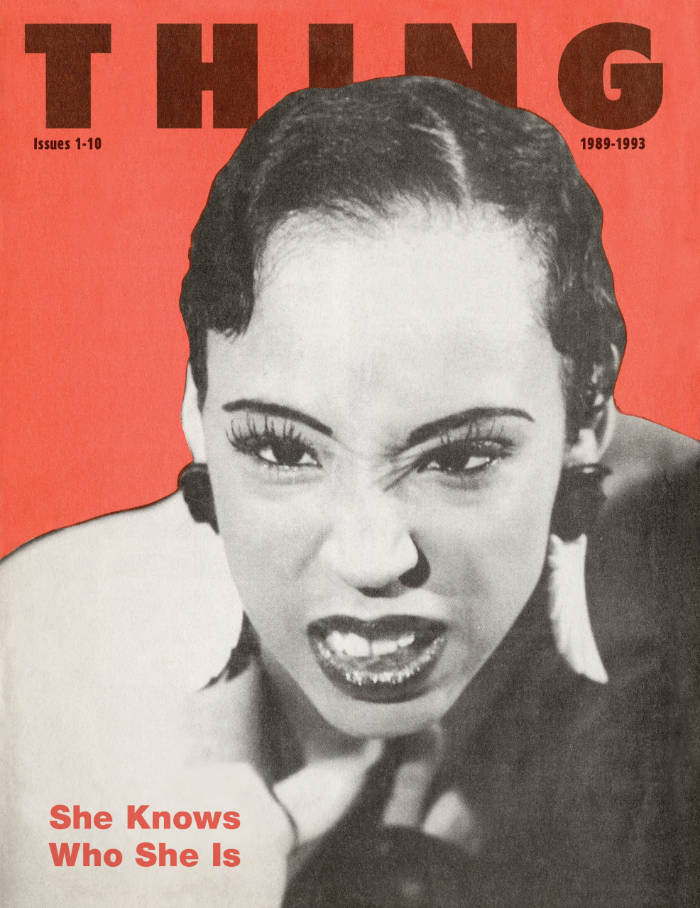
Thing
Robert Ford, Trent Adkins and 1 more
Started in 1989 by designer and writer Robert Ford, THING magazine was the voice of the Queer Black music and art scene in the early 1990s. Ford and his editors were part of the burgeoning House music scene, which originated in Chicago’s Queer underground, and some of the top DJs and musicians from that time were featured in the magazine, including Frankie Knuckles, Gemini, Larry Heard, Rupaul, and Deee-Lite. THING published ten issues from 1989-1993, before it was cut short by Ford’s death from AIDS-related illness. All ten issues of THING are collected and published here for the first time.
As House music thrived, THING captured the multidisciplinary nature of the scene, opening its pages to a wide range of subjects: poetry and gossip, fiction and art, interviews and polemics. The HIV/AIDS crisis loomed large in its contents, particularly in the personal reflections and vital treatment resources that it published. An essay by poet Essex Hemphill was published alongside the gossip columnist Michael Musto and Rupaul dished wisdom alongside a diary from the March on Washington for Lesbian, Gay, and Bi Equal Rights and Liberation. Joan Jett Blakk’s revolutionary presidential campaign is contained in these pages, as are some of the most underground, influential literary voices of the time, such as Dennis Cooper, Vaginal Davis, Gary Indiana, Marlon Riggs, David Wojnarowicz, and even David Sedaris.
THING was very much in dialogue with the club kids in New York and other Queer publishing ventures, but in many ways, it fostered an entirely unique perspective—one with more serious ambitions. In a moment when the gay community was besieged by the HIV/AIDS crisis and a wantonly cruel government, the influence and significance of this cheaply-produced newsprint magazine vastly exceeded its humble means, presenting a beautiful portrait of the ball and club culture that existed in Chicago with deep intellectual reflections. THING was a publication by and for its community and understood the fleetingness of its moment. To reencounter this work today, is to reinstate the Black voices who were so central to the history of HIV/AIDS activism and Queer and club culture, but which were often sidelined by white Queer discourse. In many ways, THING offered a blueprint for the fundamental role a magazine plays in bringing together a community, its tagline summing up the bold stakes of this important venture: “She Knows Who She Is.”
The magazine included contributions from Trent D. Adkins, Joey Arias, Aaron Avant Garde, Ed Bailey, Freddie Bain, Basscut, Belasco, Joan Jett Blakk, Simone Bouyer, Lady Bunny, Bunny & Pussy, Derrick Carter, Fire Chick, Chicklet, Stephanie Coleman, Bill Coleman, Lee Collins, Gregory Conerly, Mark Contratto, Dennis Cooper, Dorian Corey, Ed Crosby, The Darva, Vaginal Davis, Deee-Lite, Tor Dettwiler, Riley Evans, Evil, The Fabulous Pop Tarts, Mark Farina, Larry Flick, Robert Ford, Scott Free, David Gandy, Gemini, Gabriel Gomez, Roy Gonsalves, Chuck Gonzales, Tony Greene, André Halmon, Lyle Ashton Harris, Larry Heard, Essex Hemphill, Kathryn Hixson, Sterling Houston, Ishmael Houston-Jones, Gary Indiana, Candy J, Jamoo, Jazzmun, Gant Johnson, Owen Keehnen, Lady Miss Kier, Spencer Kincy, Iris Kit, Erin Krystle, Steve LaFreniere, Larvetta Larvon, Marc Loveless, Lypsinka, Malone, Marjorie Marginal, Terry A. Martin, Rodney McCoy Jr., Alan Miller, Bobby Miller, Michael Musto, Ultra Naté, Willi Ninja, Scott “Spunk” O’Hara, DeAundra Peek, Earl Pleasure, Marlon Riggs, Robert Rodi, Todd Roulette, RuPaul, Chantay Savage, David Sedaris, Rosser Shymanski, Larry Tee, Voice Farm, Lawrence D. Warren, Martha Wash, LeRoy Whitfield, Stephen Winter, David Wojnarowicz, and Hector Xtravaganza.
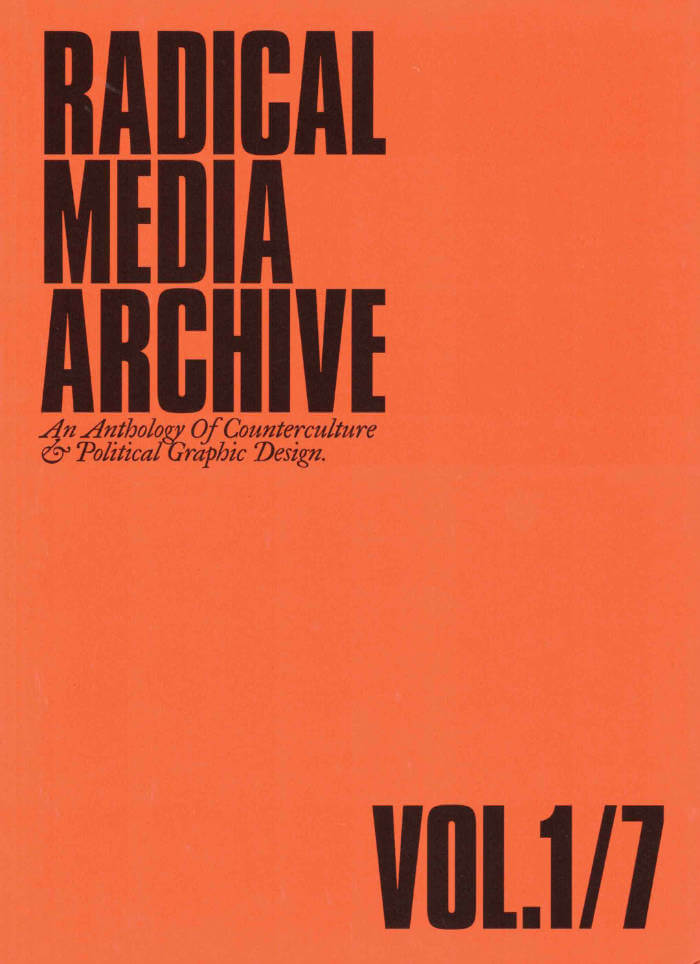
Radical Media Archive Vol 01
Ramdane Touhami, Émile Shahidi
Do you remember the last time you were looking forward to the future? We're not talking about flying cars or floating screens. We're talking about a credible vision of a better time to come. So when was the last time? How did it look? How did it feel?
Have a glance at page 223, about two-thirds in. This is a portrait of Frantz Fanon by Milton Glaser. One of the biggest names in commercial graphic design of the 20th century, painting the likeness of the giant of anti-colonial thought. Let’s leave aside the question of "who's the Milton Glaser of today?" for now, but if there was one, whose portrait would they be painting?
What we’re attempting, in these few hundred pages, is to track our favorite examples of the visual language of revolt and solidarity in the 1960s and 1970s, put them in dialogue with our most beloved works of graphic design of those decades, and celebrate the heroes who made them.
Creative currents flowing from Paris to Tokyo, Cuba to Milano, Beirut to New York, Berkeley to London, with innovations and revolutions (both political and artistic) happening every year. Causes supported by incredible talent and inspiring design that activated people, uplifted liberation movements, advanced the struggles for social justice, and created bonds of global solidarity.
Sadly this cross-pollination between commercial art and the political ended around the late 1980s and those two worlds are now completely isolated from one another.
Why do movements not produce beautiful and memorable visuals anymore? Why do the biggest image makers of today not lend their talents to the good fights that need their help? We hope that these will intersect again, and the first step is to study their history.Friends, we are here to tell you that fighting for a better world is, in fact, not only extremely cool, but the coolest thing you can do — and we have the images to prove it!
Ramdane Touhami and Émile Shahidi have spent years researching and traveling to assemble a huge collection of books, rare periodicals and radical art that will soon be available for consultation in person and online, and of which this little book is just a taste.

Designing History - Documents and the Design Imperative to Immutability
Moving beyond the usual genres of form in graphic design’s canonical history, ‘Designing History’ proposes a model centred on bureaucratic instruments of identity, ownership, value, and permission: money, passports, certificates, property deeds, etc. It considers the implications of a design history of the document, where the designer shifts from being a practitioner of conventional design histories to become subject and agency of bureaucratic authority. The book is a revised edition of ‘Immutable: Designing History’ (2022) and includes an extended essay that contextualizes the project as a remapping of graphic design’s historical, pedagogical, and practical assumptions.

Natural Enemies Of Books: A Messy History Of Women In Printing And Typography
Sara Kaaman, Maryam Fanni and 1 more
Natural Enemies of Books is a response to the groundbreaking 1937 publication 'Bookmaking on the Distaff Side', which brought together contributions by women printers, illustrators, authors, typographers, and typesetters, highlighting the print industry’s inequalities and proposing a takeover of the history of the book. Edited by feminist graphic design collective MMS, the publication includes newly commissioned essays and poems, conversations with former typesetters Inger Humlesjö, Ingegärd Waaranperä, Gail Cartmail, and Megan Downey, and reprints of the original book and other publications.

One And Many Mirrors: Perspectives On Graphic Design Education
This ambitious book brings together a wide international selection of new and recent writing by educators and practitioners who question the rules and hierarchies of graphic design education today. It holds a vivid mirror up to the ways in which graphic design is imagined, taught, received, and reproduced. Edited by two designer-educators (Brad Haylock and Luke Wood), 'One and Many Mirrors' provides an urgent overview of the field of contemporary graphic design education for all those concerned with its past, present, and possible futures.
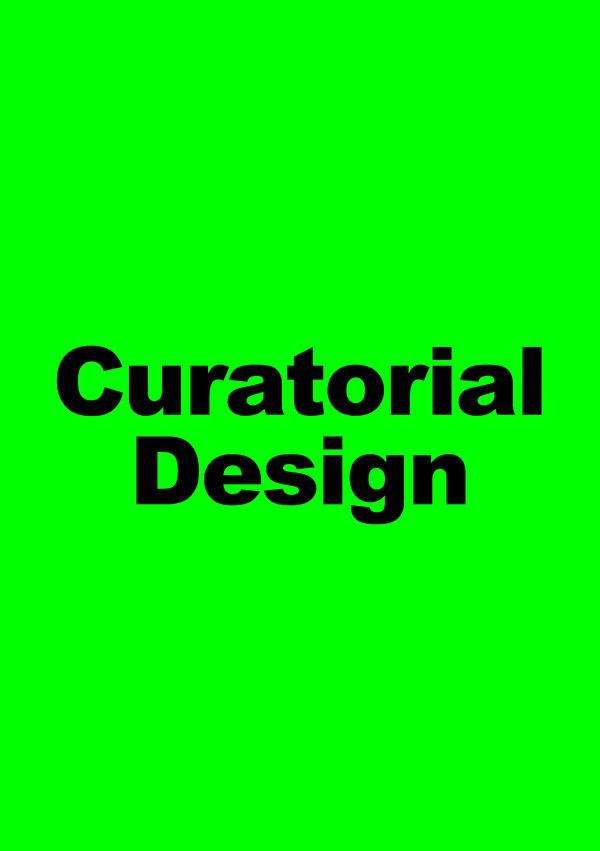
Curatorial Design – A Place Between
Wilfried Kuehn, Dubravka Sekulić
The future of architecture lies in the curatorial approach. This is the thesis put forward by architect Wilfried Kuehn and theorist Dubravka Sekulić in their book Curatorial Design: A Place Between, which brings together contributions from more than 30 authors working in the fields of architecture, art, and curatorial knowledge and practice.
Architectural design and the curatorial share a non-disciplinary background, and aim to assemble diverse forms of knowledge rather than specializing. Inherently transdisciplinary, then, they are at odds with the increasing division of labor in all fields of knowledge and practice. In the face of professionalization, which limits our capacity to intervene comprehensively, design and the curatorial challenge specialization and produce relational knowledge. They intend to create an in-between place, as together they form a novel practice that—in combining heterogenous forms of knowledge—takes center stage rather than serving as a moderator or mediator of sorts. What unites them is the assertion of a relational form, the autonomy of which consists precisely in teasing out relations between different elements. What happens to architectural design when it consciously enters a relationship with the curatorial?
The book is aimed at practitioners and educators in the field of architecture and design, as well as curators and exhibition makers. It contains three photo series by Armin Linke that accompany the three sections of the book: "Public School for Architecture", "Total Reconstruction," and "Designing for Co-Habitation."
Contributions by Martina Abri, Ross Exo Adams, Thomas Auer, Giovana Borasi, Susana Caló, Brendon Carlin, Peggy Deamer, Clémentine Deliss, FICTILIS, Francesco Garutti, Maria Shéhérazade Giudici, Joyce Hwang, Anousheh Kehar, Bettina Köhler, Elke Krasny, Wilfried Kuehn, Ippolito Pestellini Laparelli, Maxim Larrivée, Matthew Leander Kalil, Mark Lee, Steve Lyons for Not An Alternative, Armin Linke, Mona Mahall, Charlotte Malterre-Barthes, Dejan Marković, Ana Miljački, Erica Petrillo, Christian Raabe, Albert Refiti, Damon Rich, Christiane Salge, Ivonne Santoyo-Orozco, Anna Schäffler, Bernd Scherer, Laila Seewang, Dubravka Sekulić, Asli Serbest, Stuart Smith, Laurent Stalder, Milica Tomić.
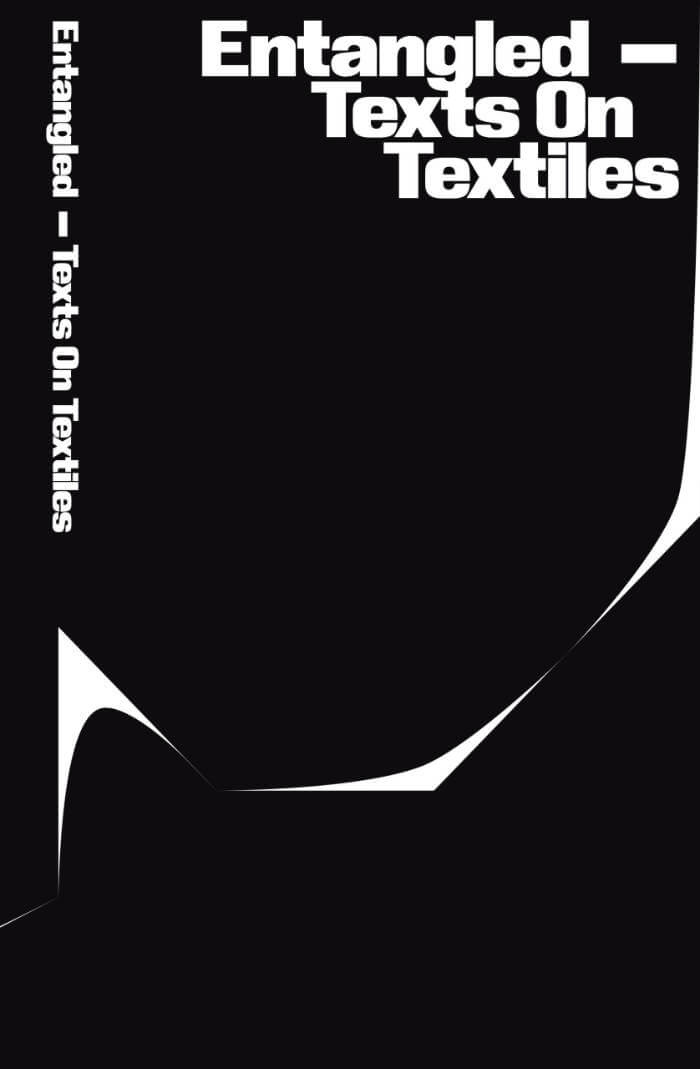
Entangled – Texts On Textiles
What does it mean to be a curator who writes, and, more specifically, how can curators write about textiles? This publication steps outside the framework of the typical exhibition catalogue to occupy "the space between literature and criticism".
The Community of writers was set up to create time and space to retreat from these outside opinions and demands and to let curiosity and the joy of writing be the driving forces of the writing process. This book has been realised under the auspice of Interweaving Structures: Fabric as Material, Method, and Message, and specifically through collaboration between the Faculty of Fine Art, Music and Design at the University of Bergen and the Central Museum of Textiles in Łódź. The two partners have strong positions of specialisation—the museum acts as a caretaker of material textile traditions and art in Poland, and the faculty has a strong textile art tradition and offers the only education programme for curators in Norway.
Edited by Anne Szefer Karlsen.
Contributions by Andreas Hoffmann, Heather Jones, Martina Petrelli, Anne Szefer Karlsen, Lea Vene, Johanna Zanon.

Who can afford to be critical?
‘Critical Designers’ produced by an increasing number of design schools are prompted to address social, political and environmental issues through their practices. Yet, who can afford to continue such effort after graduation?
In a dynamic style holding multiple voices, Who Can Afford To Be Critical? discusses the limits that affordability, class and labour impose upon the educational promise of holding a ‘critical’ practice. Why do we tend to ignore the material and socioeconomic constraints that bind us as designers, claiming instead that we can be powerful agents of change? In fact, where does our agency lie?
Instead of focusing on the dream of ethical work under capitalism, could we, instead, focus first on designers’ own working conditions, targeting them as one immediate site for collective action? And can we engage politically with the world not necessarily as designers, but as workers, as activists, as citizens?

What is post-branding?
Post-Branding empowers better design of public communication for civic and activist groups by replacing corporate branding’s predatory principles with a new set of strategies embedded in a new culture of craft. A new way of being and knowing, for a new way of relating with the world.
Brands aren’t just intruding on culture, they are our culture. They are the sponsored mechanisms for constructing and manipulating meaning and human identity. But should we cede such a fundamental human need to the market? If not, why not, and is there an alternative?
What is Post Branding? is a work of ‘practical theory’. It is a compact ‘pocket-book’ format publication composed of four main sections. The first, ‘DIS-BRANDED’, is a text of 20 short page-long chapters exposing the ideological underbelly and real-world impact of branding. The second, ‘MIXED MESSAGES’, is a provocative visual essay illuminating the texts’ main themes. The third, ‘MANUAL’, presents a framework for a critical alternative to corporate branding, humorously appropriating found instructional diagrams as a brand manual satire. This section also includes examples of completed contemporary projects that have implemented post-branding principles. The book concludes with ‘CONTEXT’, featuring a conversation with cultural theorist Brian Holmes and an argument with design historian Steven Heller.
Part design experiment, part critical theory, and part how-to-manual, What is Post-Branding? introduces a creative counter to branding’s neoliberal orthodoxy.

Design Against Design
Design Against Design argues for the urgent necessity of critical engagement and political resistance through graphic practice. It draws on insights from the practice of LOKI, a small graphic design studio committed to working with social movements towards radical political change. With conversational interviews, personal and critical essays, and a wide-ranging selection of graphic works, this book unravels the real-world relationships, motivations and contradictions involved in a socially engaged design practice.
Both a passionate indictment of the discipline of graphic design, and a utopian love letter to its radical potential, Kevin Yuen Kit Lo’s collection of almost confessional, candid essays challenge the status quo of design writing. Design Against Design demands that we think more intimately about the politics of visual culture under contemporary capitalism and, importantly, how we can act against it.
Design Against Design is organized around four key themes: Critique presents a political-economic analysis of graphic design in relationship to capitalism and considers practical ways to resist it. Practice looks critically at how designers work towards (and sometimes against) social change within both a professional studio context and alongside social movements. Materiality focuses on the craft of graphic design; on language and typography, legibility, and illegibility, on the acts of speaking and making. Autonomy considers the emotional and relational aspects of graphic design, understanding that interdependence is intricately bound to any possibility for self-determination within and beyond design.
Featuring interviews with Philippe and Nancy Vermes, Sandy Kaltenborn, Kaie Kellough, Chadi Marouf and Sabine Friesinger, Sarah Auches, and Jenn Clamen.

On Letters
On Letters is an epistolary essay, structured as thirteen wide-ranging and personal letters to the late conceptual artist On Kawara. Playing with language and its limits, the letters focus first on the artist’s five decade long body of “Date Paintings” and their relationship to typography. Yet from this starting point, the writing swerves to encompass topics such as the creative process, mindfulness, numbering systems, race, narrative structures, and more. On Letters is a unique glimpse into one artist’s inner dialogue and an exploration of how the solitary practice of artmaking can spark other transformations in the world.
"No one is better placed to reflect on On Kawara’s perfect marriage of typography and ontology than Prem Krishnamurthy. An intellectual triumph and a true labour of love." —Tom McCarthy
Prem Krishnamurthy (b. 1977) is a designer, author, and educator. He directs Wkshps, a multidisciplinary design consultancy and organizes Department of Transformation, an emergent, itinerant workshop that practices collaborative tools for social change. He has directed and curated large-scale exhibitions including Oh, Gods of Dust and Rainbows, the 2022 edition of FRONT International: Cleveland Triennial for Contemporary Art; Our Silver City, 2094 at Nottingham Contemporary; and Ministry of Graphic Design in Sharjah, UAE.

What Design Can’t Do: Essays on Design and Disillusion
Design is broken. Young and not-so-young designers are becoming increasingly aware of this. Many feel impotent: they were told they had the tools to make the world a better place, but instead the world takes its toll on them. Beyond a haze of hype and bold claims lies a barren land of self-doubt and impostor syndrome. Although these ‘feels’ might be the Millennial norm, design culture reinforces them. In conferences we learn that “with great power comes great responsibility” but, when it comes to real-life clients, all they ask is to “make the logo bigger.”
This book probes the disillusionment that permeates design. It tackles the deskilling effects provoked by digital semi-automation, the instances of ornamental politics fashioned to please the museum-educational complex, the nebulous promises of design schools. While reviving historical expressions of disenchantment, Silvio Lorusso examines present-day memes and social media rants. To depict this disheartening crisis, he crafts a new critical vocabulary for readers to build upon. What this exposé reveals is both worrying and refreshing: rather than producing a meaningful order, design might be just about inhabiting chaos.
What was once a promising field rooted in problem-solving has become a problem in itself. The skill set of designers appears shaky and insubstantial – their expertise is received with indifference, their know-how is trivialised by online services, their work is compromised by a series of unruly external factors. If you see yourself as a designer without qualities; if you feel cheated, disappointed or betrayed by design, this book is for you.

The Mollino Set
New York-based professor Lytle Shaw journeys to Italy in this adventurous exploration of the life and work of architect, designer, and photographer Carlo Mollino (1905–1973). In 1933 the young Mollino received a commission from Mussolini’s regime for his first building: an administrative centre in Piedmont. Later works include furniture and interior design, a book on photography, and an asymmetrical car that raced at Le Mans in 1955.
The book centres around Shaw’s realisation that this prolific talent’s conflicted legacy offers a unique window on the role that post-war Italian politics and culture played in the country’s reimagining of itself as a victim, rather than a proponent, of fascism.
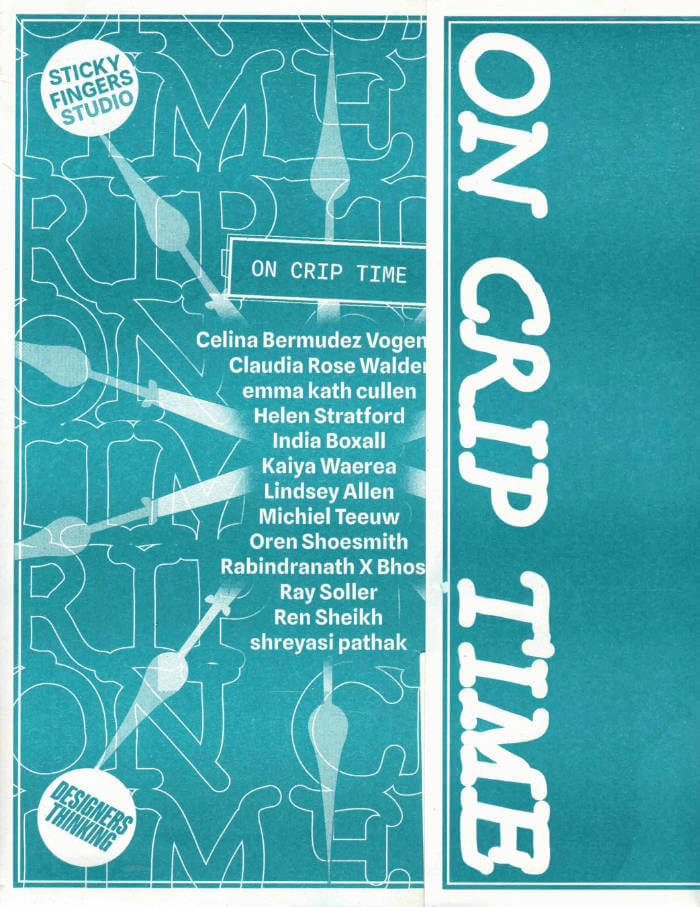
On Crip Time
This publication brings together works produced during the ‘Woke Designers Reading Club: Designing on Crip Time’ programme devised by Kaiya Waerea and Michiel Teeuw in Autumn 2022. Here we gathered to read, watch, listen and write through questions orbiting around how systems of time are enforced to prevent disabled people from accessing the future.
In this publication, you will find a range of unruly resistances. From flowcharts of lives lived and unliveable, to prayer mats, to posters, to diagrams cartographing time, to manifestos for being in a world that is built to erase us.
Designed by converger / Michiel Teeuw
Printed and finished by Sticky Fingers Studio
Featuring Celina Bermudez Vogensen, Claudia Rose Walder, emma kath cullen, Helen Stratford, India Boxall, Lindsey Allen, Michiel Teeuw, Oren Shoesmith, Rabindranath X Bhose, Ray Soller, Ren Sheikh & shreyasi pathak, with an introduction by Kaiya Waerea.
23x18cm finished size, includes an A5 24pp pamphlet, 6 A3 unbound sheets & 1 A3 wrap cover, risograph printed throughout
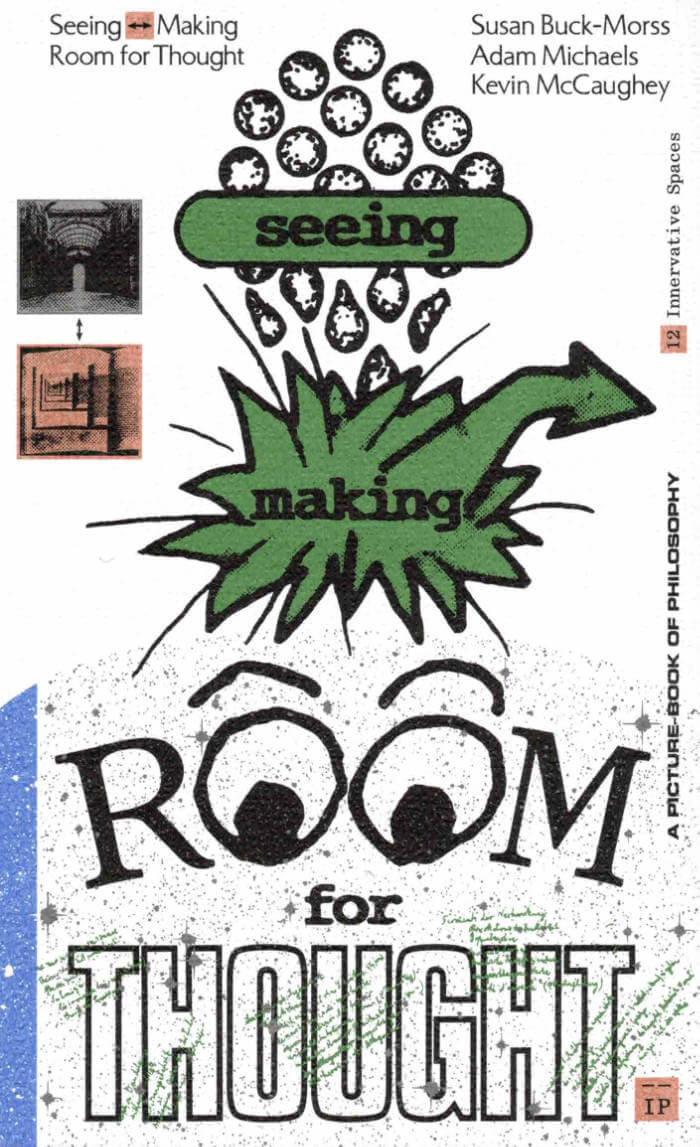
Seeing Making: Room for Thought
Adam Michaels, Kevin McCaughey and 1 more
Seeing <―> Making: Room for Thought both studies and presents the creative process of constructing ideas with images. By activating the techniques of montage, the book reveals a wide field of view and a space to engage new critical connection between a multiplicity of objects from the past and present. Realized through an intergenerational collaboration of three cultural producers committed to making theory visible, a transformative anthology of critical essays by Susan Buck-Morss anchors this kaleidoscopic project. Images and ideas sync with Buck-Morss’ perceptive texts on visual culture, history, politics, and aesthetics, fusing criticism with visual play and linking collective imagination and social action.
Building upon the methods and ways of seeing put forth by visual thinkers like Walter Benjamin and John Berger, designer Kevin McCaughey (Boot Boyz Biz), designer, editor, and publisher Adam Michaels (IN-FO.CO/Inventory Press), and renowned theorist Buck-Morss collectively assemble colliding material into new relation. What results is a (typo-) graphic articulation that thinks seriously about the stakes of ideation and reorients the space of the book in the service of a theory and philosophy that speaks the language of our image-based information age.

Viscose 05: Retail
Viscose is a journal for fashion criticism. The fifth issue of Viscose explores fashion’s multifaceted retail spaces and cultures. With the evolution of shopping in the 20th and 21st centuries as its focus, the issue looks at the shop as a central nexus where communities and identities are continuously produced and re-imagined through commerce. With a special attention to the role of fashion retail within urban spatial politics, we seek out histories of projects—often developed with or by artists—that have embraced the shop as a medium of both possibility and contestation.
With contributions by:
Dennis Brzek, Anastasia Howe Bukowski, Michael Bullock, Felix Burrichter, Canal Street Research Association, Noah Dillon, Harun Farocki, Anna Franceschini, Ignacio Gatica, Christian Hincapié, Juje Hsiung, Jessica Kwok, Rhonda Lieberman, Matthew Linde, Marge Monko, Cheuk Ng, Luis Ortega, Camila Palomino, Andreas Petrossiants, Leah Pires, International Library For Fashion Research, Vésma Kontere Mcquillan (International Library For Fashion Research), Rose Salane, Alice Sarmiento, Museum Of Modern Shopping, Jeppe Ugelvig, Sean Vegezzi, Post Vsop, Evie Ward, Leah Weirer
.jpg)


Commons in Design
The scarcity of resources, climate change, and the digitalization of everyday life are fuelling the economy of swapping, sharing, and lending—all of which are in some way linked to a culture of commoning. In this context, we understand commons as community-based processes that use, collectively manage, and organize generally accessible resources—referring to both goods and knowledge.
Commons in Design explores the meaning and impact of commons—especially knowledge-based peer commons—and acts of commoning in design. It discusses networked, participatory, and open procedures based on the commons and commoning, testing models that negotiate the use of commons within design processes. In doing so, it critically engages with questions regarding designers’ positionings, everyday practices, self-understandings, ways of working, and approaches to education.
Contributors: Rachel Armstrong, Errantry Media Lab (Max Stearns & Nathalie Attallah), Yuhe Ge, Juan Gomez, Luis Guerra, Katherin Gutiérrez Herrera, Cyrus Khalatbari, Rilla Khaled, Cindy Kohtala, Torange Khonsari, Álvaro Mercado Jara, Nan O’Sullivan, Victoria Paeva, Sharon Prendeville, Zoe Romano, Gregoire Rousseau, Daniela Salgado Cofré, Christine Schranz, Elpitha Tsoutsounakis, Eva Verhoeven, Jennifer Whitty
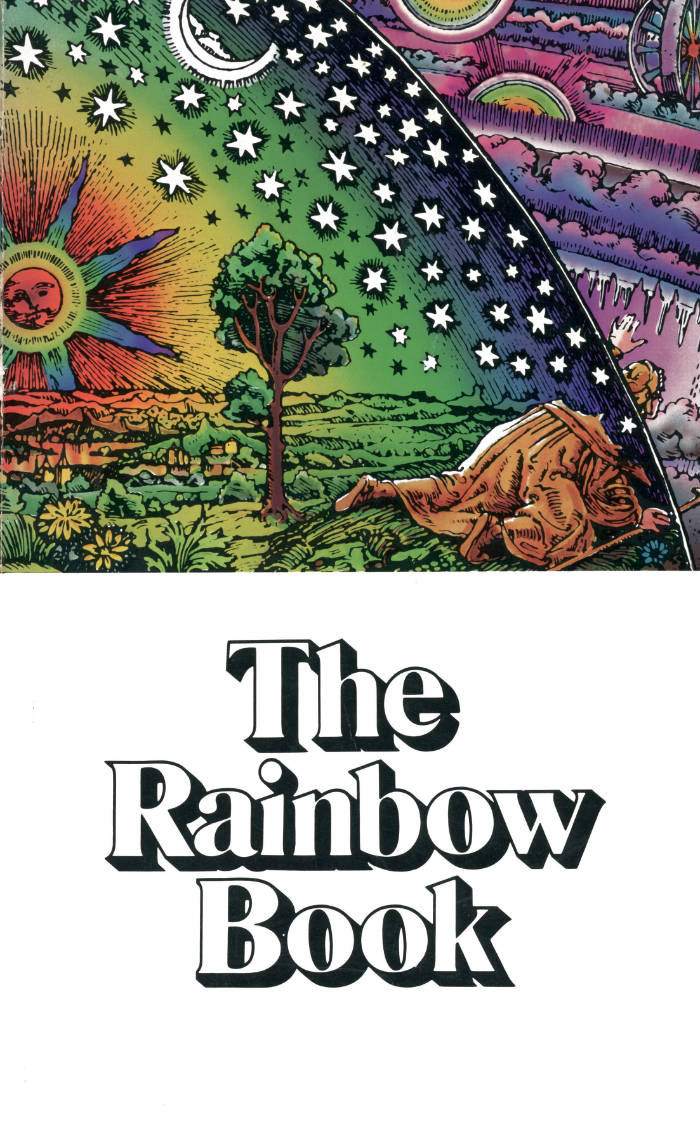
The Rainbow Book
F. Lanier Graham, Larry Wurn and 1 more
The book is a reprint of a cult text of post-1968 psychedelic culture: The Rainbow Book, published in 1975 in Berkeley, California, on the occasion of The Rainbow Show exhibition held at the Fine Arts Museums of San Francisco.
The Rainbow Book is a collection of essays and illustrations devoted to the rainbow and color spectra, analyzing the significance of color (both physical and metaphysical) from antiquity to modern times.
An encyclopedia of the cultural and artistic manifestations of the rainbow: in myth, magic and paintings, as well as in prints and poems. The book includes poems by Virgil, Dante, Blake, Keats, Wordsworth, and others; paintings by Giotto, Bosch, Van der Weyden, Dürer, Rubens, Blake, Turner, Constable, and Church; and the sacred art of Tibet.
The book is printed on sheets of different colors, according to the rainbow spectrum, and reports notions of increasing complexity, accessible at first to younger readers and later to the more experienced and interested in the subject.
The reprint accompanies the exhibition Rainbow. Colors and Wonders between Myths, Arts and Science at MUDEC in Milan (February 16–July 2, 2023), and the release of the first issue of MUdec United.